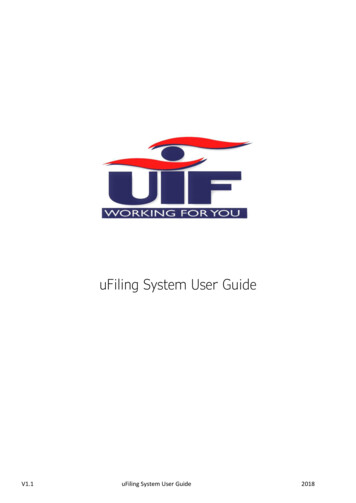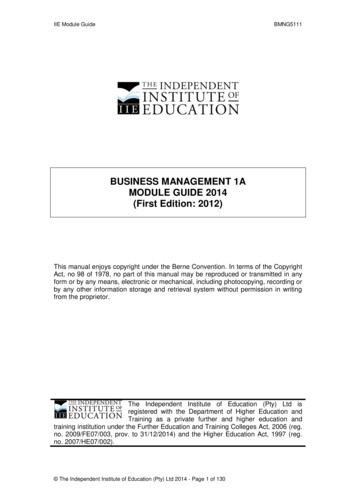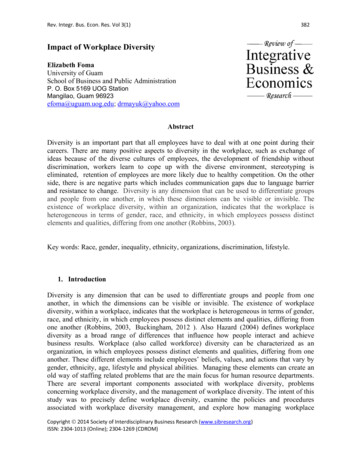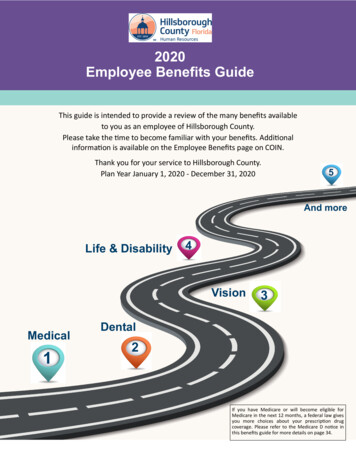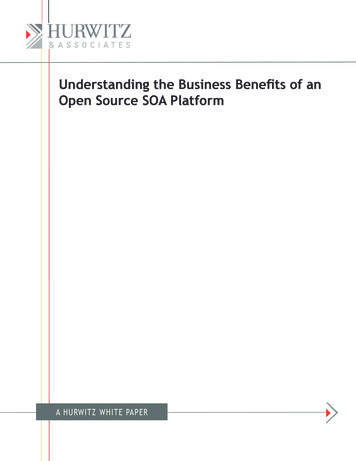
Transcription
Understanding the Business Benefits of anOpen Source SOA PlatformA Hurwitz white Paper
Copyright 2009, Hurwitz & AssociatesAll rights reserved. No part of this publication may be reproduced or stored in aretrieval system or transmitted in any form or by any means, without the prior writtenpermission of the copyright holder. Hurwitz & Associates is the sole copyright ownerof this publication. All trademarks herein are the property of their respective owners. 233 Needham Street Newton, MA 02464 Tel: 617 454 1030 www.hurwitz.comHurwitz White Paper
Understanding the Business Benefits of an Open Source SOA PlatformContentsIntroduction.1The Business Need for SOA.2Understanding the Benefits of SOA.4Tangible SOA Busisness Payback.4Introducing JBoss Enterprise Middleware.6Conclusion: Open Source SOA Works.8Hurwitz White Paper
Understanding the Business Benefits of an Open Source SOA PlatformIntroductionSOA simplifiesand speeds theautomation ofbusiness processesby deliveringthe desiredfunctionality asservices.In a highly competitive business environment, the ability to adapt the informationtechnology infrastructure quickly is imperative. Many businesses are turning toa Service Oriented Architecture (SOA) to create a flexible infrastructure. SOAenables organizations to build and deploy IT systems that directly serve the goals ofthe business faster and more easily than traditional approaches. A business servicesapproach helps businesses and IT to establish a common language of communication,align IT with business needs, and facilitate change. SOA, in short, allows businesses toadapt their IT to meet frequently changing business challenges.SOA is an approach to building IT systems that allows businesses to leverageexisting assets—in the form of reusable services—to support business change. SOAsimplifies and speeds the automation of business processes by delivering the desiredfunctionality as services. Because services request the required functionality througha standards-based interface, the need to change backend systems is eliminated. Inthe process, services can be combined and recombined in various ways to automatea given process. The major components typically included in a service orientedarchitecture are illustrated in Figure 1 below. The Enterprise Service Bus (ESB) shownin the center of the diagram is responsible for passing secure and reliable messagesbetween the different components of the SOA. All of the component parts aredesigned to work together in a standardized and repeatable way leading to a consistentquality of service.Figure 1. Fundamental SOA ComponentsSOA For Dummies, 2nd Edition, Wiley 2008Hurwitz White Paper
Understanding the Business Benefits of an Open Source SOA PlatformOpen source has been proven particularly effective when implementing SOA. Usingopen source reduces the cost of tools while providing a range of options fromdifferent providers. Having access to the source code also eliminates concerns aboutvendor lock-in. Finally, open source offers a broad and supportive community andecosystem to support the SOA initiative. At the same time, commercial open sourceSOA tools carry with them the full support of a well-established vendor.While eachcompany isdifferent, manyshare commonbusiness goals, suchas lowering IT costsor enabling rapidchange.This paper is divided into two sections. The first half of the paper describes thebusiness challenges of three JBoss Enterprise Middleware customers and how theygained business benefit from the use of JBoss Enterprise products and services. Thesecond half of the paper provides insight into the JBoss Enterprise SOA platform.The Business Need for SOAHurwitz & Associates has interviewed hundreds of companies that are moving toSOA. While each company is different, many share common business goals, suchas lowering IT costs or enabling rapid change. The following companies each facedserious business challenges that SOA helped them overcome:Information distributor: A global information distributor found itself strugglingto aggregate and integrate information from multiple proprietary legacy systems andrein in rapidly escalating IT costs. The various independent data stores, with datafrom over 200 different sources, required significant manual intervention to ensurethe delivery of accurate information to its customers: re-formatting and accuracychecking involved numerous manual steps. The process was labor-intensive, costly,and very slow, thereby frustrating the company’s customers who demanded morerapid access to the information than could be provided.The company recognized that it needed to move to SOA in order to reach its goalof increasing both the speed of delivery and the quality of information it providedto customers. The services approach required streamlining application and dataintegration through the use of standards-based services and interfaces that left thebackend systems untouched.Railway: Similarly, a national European railway, which carries over 100,000passengers per day, realized it needed to integrate a diverse set of IT systems.Specifically, it wanted to create a common IT platform to support a wide rangeof applications—from HR to sales to operations—and access these applicationsthrough a variety of platforms including servers, PCs and handheld devices. Therailway had previously been coding point-to-point integration, which was slow, errorprone, and costly to maintain. The railway’s management turned to SOA in the hopethat it would now only enable the railway to reduce IT integration cost by providingHurwitz White Paper2
Understanding the Business Benefits of an Open Source SOA Platforma common standards-based IT platform, but would also speed development of newapplications and capabilities. a largegovernment agencyturned to SOA tosolve its documentmanagementproblem.Government agency: A third organization, a large government agency, turned toSOA to solve its document management problem. The agency receives a large numberof documents daily and needs to make them available to its users to perform thework of the agency. However, the agency was under tight budget constraints. Workingwith its consulting firm, the agency started by building J2EE services that connectedthrough the JBoss ESB. Faced with a situation in which there was no predictabledocument flow, the agency built a business-driven system based on services thatwould extract document meta data, categorize and index specific text, preparedocuments for user search and retrieval, and even do translation. Figure 2 illustratesthe agency’s approach.Figure 2. Flow Chart of Government Agency Document Management SOASolutionAll three of these organizations succeeded in their SOA initiatives. The businessresults they achieved are summarized in the following sections.Hurwitz White Paper
Understanding the Business Benefits of an Open Source SOA PlatformUnderstanding the Benefits of SOASOA, in effect,allows the businessto enhanceoverall businessperformance andprofitability.Companies implement a services approach when they build IT systems in order toleverage existing assets and make rapid, efficient, and cost-effective changes to itsIT systems when required. Technically, SOA provides the architecture for buildingbusiness applications as a set of loosely coupled black-box components that areorchestrated to deliver a well-defined level of service by linking together businessprocesses. In so doing SOA helps the business to keep its focus on business whileallowing IT to evolve and keep pace with a dynamically changing world.Furthermore, through the use of services—recognizable codified tasks combined withappropriate rules and policies—SOA separates IT functionality from the underlyingsystems, whatever they may be. In this way SOA frees the business from technologyconstraints that previously hindered business flexibility and responsiveness to change.It helps the business leverage existing assets and create new assets in the form ofreusable services. Through SOA, organizations can create, combine, and recombinethese services as needed to support the task at hand—whatever that task may be.SOA makes building and deploying IT systems that directly serve the goals of abusiness easier and faster. SOA integrates business requirements with an IT frameworkthat simultaneously leverages existing systems and enables business change, thusleading the business to improve the quality of its systems and data through betterbusiness and IT governance and through reuse of proven rules, policies, and softwareassets. In the process SOA adds predictability and consistency through business rules,policy, and reusable software services.Freed from the underlying technology constraints and able to integrate systems faster,more easily, and at much lower cost, the business stands to lower its IT total cost ofowner and boost the return on its IT investment. SOA, in effect, allows the business toenhance overall business performance and profitability. The three companies describedabove all determined that SOA provided these types of impressive benefits.Tangible SOA Business PaybackBy selecting a subscription to the JBoss Enterprise SOA Platform and taking advantageof professional services provided by Red Hat, the global information distributorwas able to make very significant changes to its technical infrastructure and still keepcosts under control. Other business benefits included data quality improvements thatallowed its business analysts to spend more time focusing on data analysis. The SOAinitiative increased the overall flexibility and efficiency of the information company’sbusiness processes, enabling it to increase the timeliness, accuracy, and quality of theinformation delivered to its customers.Hurwitz White Paper4
Understanding the Business Benefits of an Open Source SOA PlatformTo get these results the company leveraged the savings from choosing JBossEnterprise SOA Platform over a more expensive proprietary option to invest in newIT hardware and hire people with SOA technical skills, created a master dictionary toorganize and define incoming data, and developed a master tag library to streamlineintegration. Using JBoss, the company developed an orchestration engine that couldadapt to changing business conditions by handling changes in data feeds on the flythrough SOA rules-based services. It created other services to normalize and enhancethe data. For example, it was able to replace eight different data decoders with a singleSOA-based service.SOA made itpossible for thecompany to shiftpersonnel fromdata operations toproduct strategyand other areas ofhigher value to thebusiness.Through the use of such services, SOA made it possible for the company to shiftpersonnel from data operations to product strategy and other areas of higher valueto the business. The company also was able to leverage its fast and efficient SOAoperations to add valuable new business services.The European railway, using Red Hat and JBoss technology, built a SOA integrationplatform that delivered increased ROI for the railway. A ticket-auction applicationbuilt around a set of interoperating services, for instance, took just four months tocomplete and led to the sale of an extra 1,500 tickets per week—tickets that previouslywent unsold. With SOA, the railway now measures its IT ROI in weeks rather thanmonths.Assisted initially by Red Hat with professional integration and training services, therailway established a SOA integration center of excellence that can rapidly deliver costeffective, integrated SOA projects across the entire business. It intends to continue toregularly roll out SOA initiatives similar to the ticket auction.The information distribution company opted for a subscription to the JBossEnterprise SOA Platform because it delivered comprehensive SOA functionalityat an affordable price. The European railway selected JBoss because in pilots itdemonstrated the ability to deliver dramatic application performance improvementsover competing products. In addition, both companies wanted to take advantage ofthe Red Hat/JBoss professional SOA support and services.The government agency opted for JBoss Enterprise SOA Platform because it couldstart small yet scale very large. It began by implementing the ESB portion of the JBossEnterprise SOA Platform for automated transport, message routing, and protocoltranslation. A central registry contained a variety of document handlers while theagency resolved issues arising from multiple data sources with the JBoss EnterpriseData Services Platform (MetaMatrix) to ensure a unified view. All the variouscomponents easily integrated within the JBoss Enterprise Application Platform.Hurwitz White Paper
Understanding the Business Benefits of an Open Source SOA PlatformWithin three years, the SOA-based document automation system had become sopopular it was handling in excess of 100,000 documents a day and supporting a 600%increase in users with no problem.The JBossEnterprise SOAPlatform andother middlewareproducts in theportfolio enablethe integrationand orchestrationof applicationcomponents andservices.Introducing JBoss Enterprise MiddlewareJBoss, owned by open source solutions provider Red Hat, is a provider of open sourcemiddleware software. The JBoss.org Community is a thriving and innovative opensource community. Projects developed through the Community are hardened by JBossand then integrated into a comprehensive portfolio of stable, supported, enterpriseclass solutions that support the entire application lifecycle. The JBoss EnterpriseMiddleware portfolio includes application, portal, data integration, and ESB-basedSOA platforms, as well as development and management tools. JBoss EnterpriseMiddleware is available via subscriptions that include patches, updates, support, multiyear maintenance policies, and software assurance.The JBoss Enterprise SOA Platform and other middleware products in the portfolioenable the integration and orchestration of application components and services.(See Figure 3.) Packaged as a modular distribution, the JBoss Enterprise SOAPlatform integrates multiple components, including messaging, service orchestrationand workflow, and policy and governance along with SOA design, development, andmanagement.Figure 3. JBoss Enterprise SOA Platform ComponentsKey JBoss Enterprise SOA Platform components include: JBoss Enterprise Service Bus (ESB)—enables any-to-any message deliverywhile performing the necessary message transformation and routing to ensureHurwitz White Paper6
Understanding the Business Benefits of an Open Source SOA Platformmessages between SOA services are received and understood. JBoss ESB is anext generation ESB that enables EAI, SOA and EDA styles of integration ina single platform. The ESB is central to eliminating the need for point-to-pointconnectors. JBoss Rules—provides a business rules engine that enables greater business agilityresponding to a changing regulatory and competitive environment. Rules areparticularly important in ensuring compliance and mitigating risk. JBoss jBPM—provides enterprise business process integration, orchestration, andautomation. Orchestration, specially, enables control of the information flow andservice interactions among dozens, even hundreds of interoperating services andsystems and binds them together to deliver business value.There are other key offerings from the JBoss Enterprise Middleware portfolio thatcan be used with the JBoss Enterprise SOA Platform as part of a comprehensive SOAdevelopment, deployment and management solution. They are: JBoss Operations Network—comes with the JBoss Enterprise SOA Platformsubscription and delivers basic JBoss SOA administration capabilities includingpatch management, install/deploy, and provisioning. An optional monitoringupgrade adds SOA service monitoring features. JBoss Developer Studio—integrated open source development environment usedto create and deploy reusable services, including business rules authoring and tocombine services into SOA business applications. JBoss Developer Studio includesthe JBoss Enterprise SOA Platform for development purposes. In addition toJBoss Developer Studio, which delivers just the software with no support, Red hatalso offers Red Hat Developer subscriptions that provide developer support for allJBoss Enterprise Middleware and Red Hat Enterprise Linux.In addition to the JBoss Enterprise SOA Platform, the company offers the JBossEnterprise Data Services Platform (MetaMatrix). It provides a set of data managementcapabilities including data integration, data services federation, and data abstraction sothat the SOA environment can properly handle diverse data consistently.Other JBoss Enterprise Middleware products that support SOA Deployment include: JBoss Enterprise Application Platform—provides a SOA service hostingenvironment. JBoss Enterprise Portal Platform—provides a personalized experience interactingwith SOA-enabled business processes and applications.Hurwitz White Paper Within three yearsthe resultingsystem allowedthe agency toconsolidate 55underutilizedservers into justeight servers andstill have capacityavailable for moregrowth in thefuture.
Understanding the Business Benefits of an Open Source SOA PlatformConclusion: Open Source SOA WorksThe lesson in allthree cases—theinformationdistributor, theEuropean railway,and the governmentagency—is clear:the combination ofSOA and enterpriseclass commercialopen sourcetechnology help anorganization solvedifficult businessproblems.The business problems that organizations face today continue to be difficult and areonly compounded by the current economic turmoil. Systems remain hard to integrate,and changing applications remains a slow and costly endeavor. Budgets are tight, evenat big government agencies. SOA, however, provides an effective and efficient answerto these difficult challenges as it delivers significant business value.As noted above the government agency turned to SOA services to implement abusiness process-driven messaging infrastructure based on commercial open sourcetechnology. Within three years the resulting system allowed the agency to consolidate55 underutilized servers into just eight servers and still have capacity available for moregrowth in the future. SOA also gave the agency flexibility and scalability, allowing it toquickly scale processing from 18,000 documents to more than 100,000 documents perday. The system absorbed a 600% increase in users without missing a beat.The lesson in all three cases—the information distributor, the European railway,and the government agency—is clear: the combination of SOA and enterprise-classcommercial open source technology help an organization solve difficult businessproblems by expediting IT integration, eliminating IT and business pain points,reducing errors, and enabling flexibility and scalability. These SOA initiatives helped theorganizations lower costs, speed the deployment of new capabilities, boost businessperformance, and better align IT and the business for the purpose of increasingbusiness value and improving the customer’s experience. And it did so at a cost eachcould afford. That is the power of commercial open source SOA.Hurwitz White Paper8
Understanding the Business Benefits of an Open Source SOA PlatformAbout Hurwitz & AssociatesHurwitz & Associates is a consulting, research and analyst firm that focuses on thecustomer benefits derived when advanced and emerging software technologies areused to solve business problems. The firm’s research concentrates on understandingthe business value of software technologies, such as Service Oriented Architectureand Web services, and how they are successfully implemented within highly distributedcomputing environments. Additional information on Hurwitz & Associates can befound at www.hurwitz.com. Hurwitz White Paper
Sep 09, 2017 · Figure 1. Fundamental SOA Components SOA For Dummies, 2nd Edition, Wiley 2008 Understanding the Business Benefits of an Open Source SOA Platform SOA sim

